Cornwall Hardy Plant Society had Fergus Garrett as their speaker on Wednesday and three days later my head is still buzzing. He talked fast and he packed in so much content, all about what he calls layering, the business of building communities of plants growing together such that a piece of ground has something interesting happening in it at all times of the year. It’s something I’ve been trying to achieve for years but it became all too clear I’ve not reached first base yet. It didn’t leave me downhearted though, rather the opposite, fired up to do better.
Dixter would have no problem coming up with six things on a Saturday, they could do six every day of the week, all year round, and have plenty to spare. I went round on Friday afternoon and took pictures of about ten things but the number is slowly dropping towards six and then below. I offer up this lot:
One.
Nerines. Barely happening, I move them all last year and there should be a broad swathe along the side of this path. Instead, almost nothing. They evidently don’t like being moved. I’m hoping for better things next year.
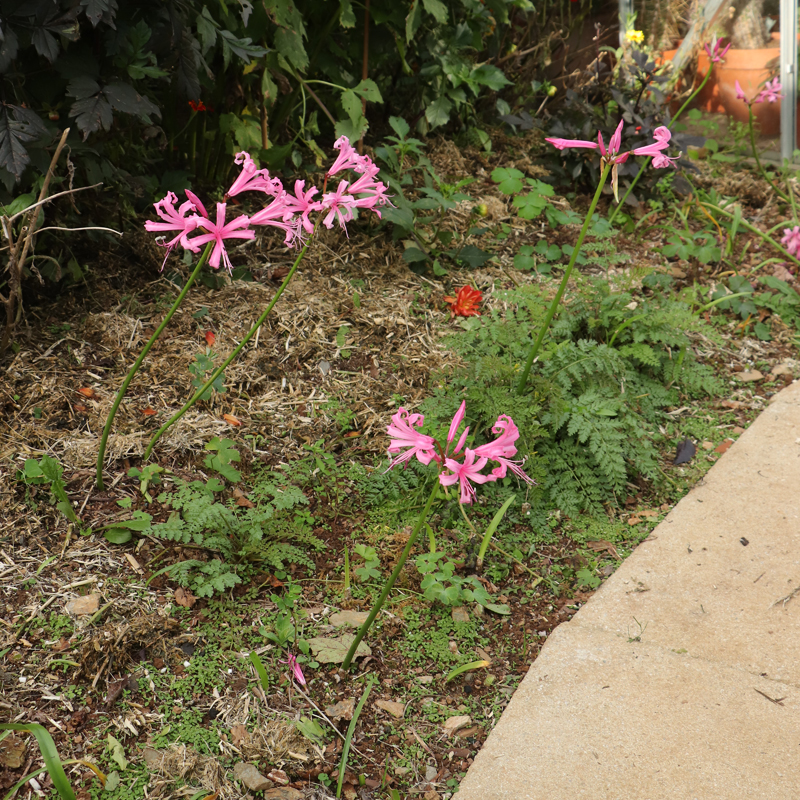
Two.
On the other hand Amaryllis belladonna are having a pretty good year. I don’t remember having this sort out the front but here they are. I’ve another clump in the back garden that need moving, I suppose they’ll go into a sulk too.
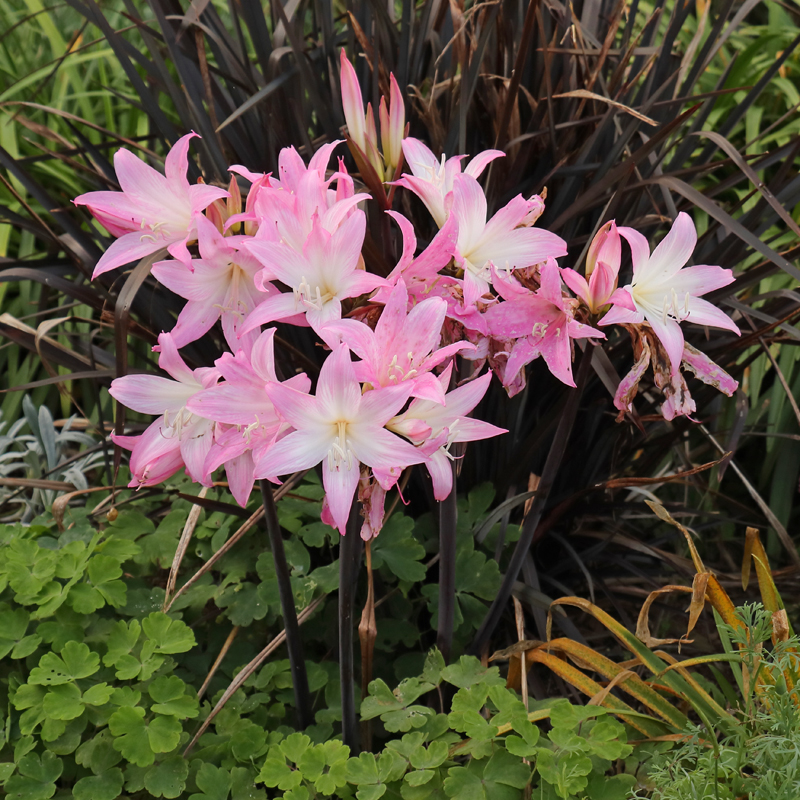
Three.
I took the Amaryllis picture and looked up a bit, thought that for October the front garden, which is pretty small, was punching above its weight. Fergus came back again and again to the notion of making your eyes do some work, by which he meant you need contrast, in colour, shape, texture or whatever. Look for the homogenous areas of your planting and change something. I love the way the Echiums are echoed in the top-knots of the Eucomis behind them. If they survive the winter they’ll be monsters next year.
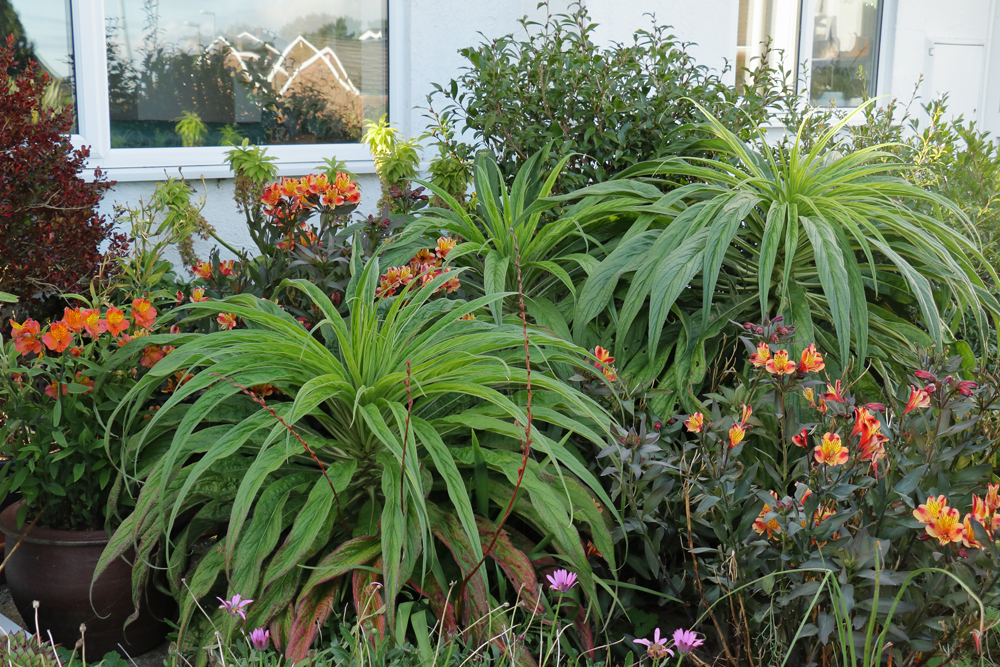
Four.
Geranium ‘Little Monster’. Plants with inappropriate names are common enough, there are fewer with outstandingly appropriate names. I planted this, moved it because it was too big where it was. Now I have it where I moved it and where it started out too, plus at least one equally thuggish seedling. The crown of the plant is quite compact but the amount of growth it makes in a season is something else.
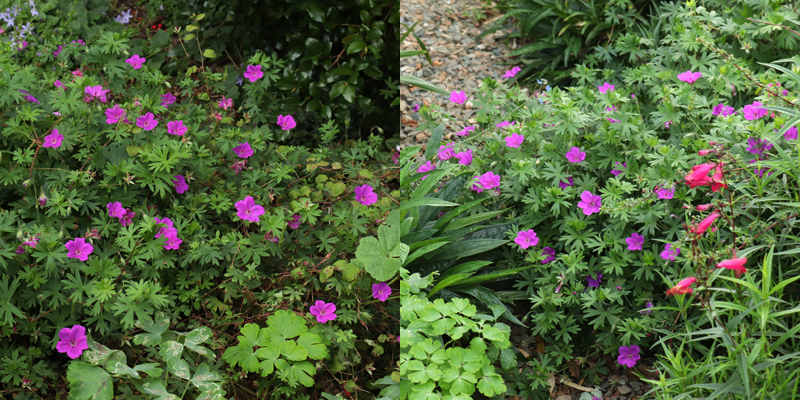
Five.
“Joan’s Aster”. As in it came from the garden of a lady called Joan and I don’t know its name. Having massacred a million slugs and more than a few adult wine weasels on the two clumps we have of it this year it has grown much better than usual and collapsed in all directions. Perhaps I should have done a Chelsea chop, perhaps I should have staked it. One clump was in afternoon sunlight, the other in shade; they’re the same colour really.

Six.
As good as it is to grow something new and different, gardeners get regular reminders of why some plants are popular and common and have stood the test of time. Like Fuchsia ‘Mrs Popple’. Raised in 1899 it is vigorous, hardy, free flowering with large blooms for a hardy variety. I’ve been cutting all our Fuchsias to the ground in late winter for the last few years becasue of gall mite so they’re flowering pretty late, but I’m happy with that.
The sun is starting to break through the mist this morning, picking out the cobwebs festooning every plant in the garden. I shall press on with digging things up and moving them about, moving tender plants under cover, chopping things down and shredding them. The same old same old. Checking the links to other sixers at The Propagator’s, the Saturday routine.
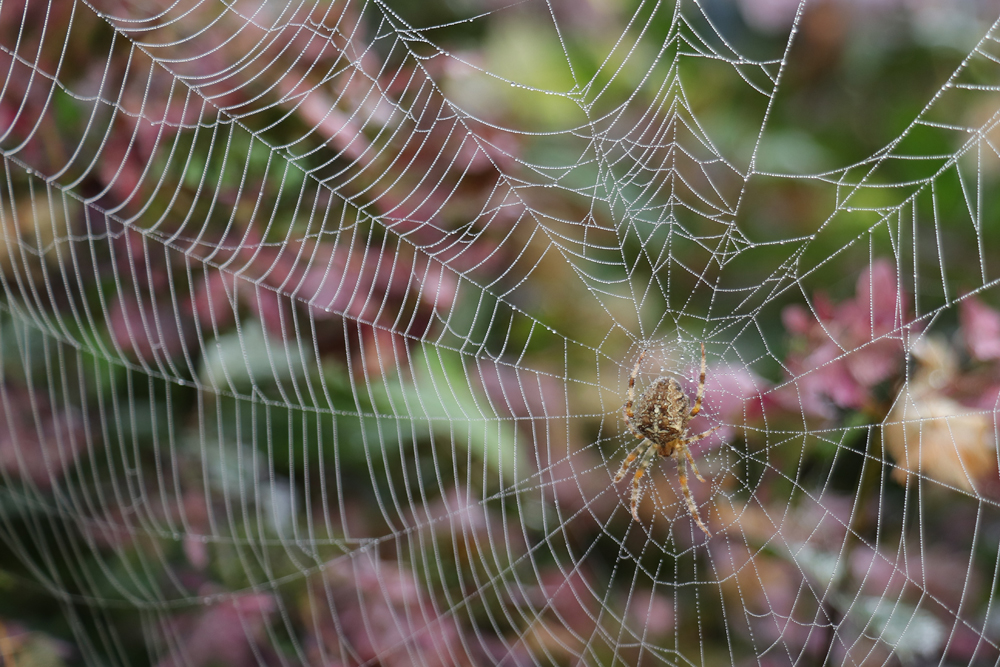
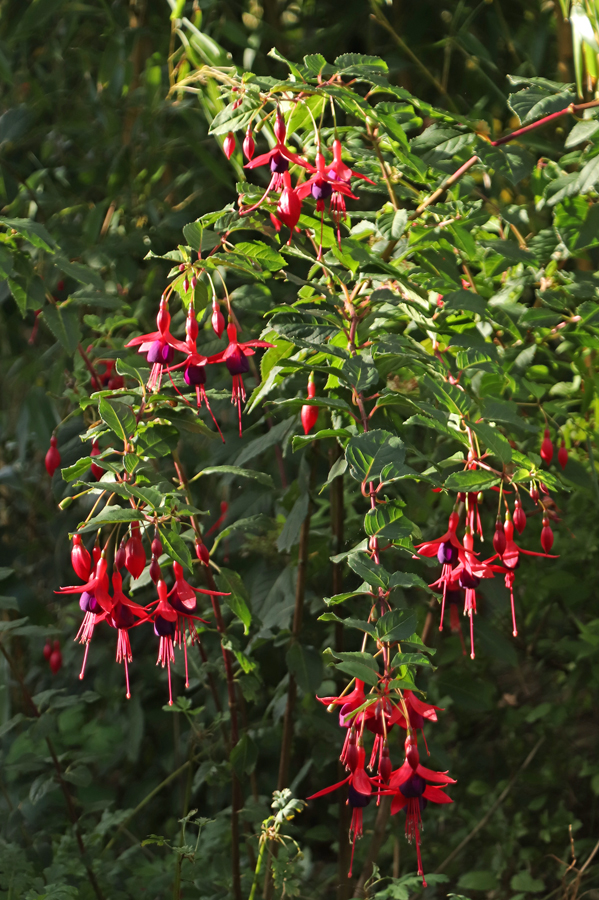
Sounds like the Fergus Garret talk was a great motivator. I keep picking up an old book I have by Christopher Lloyd called Succession Planting and as you say its about making those contrasts in foliage and filling the seasonal gaps. I do like your combination of eucomis, echiums and alstromeria. You have three more nerines than me! Good luck for next year, it will look fab.
LikeLike
I just ordered the book, second hand on Amazon. Lots of changes in hand for next year, as always.
LikeLike
I love the amaryllis, Jim!
LikeLike
Tony has been making me dig a little deeper around them, metaphorically speaking. I’m motivated to look out for different varieties, given that I have two forms that seem to flower comparatively reliably here.
LikeLiked by 1 person
The echiums are incredibly vital looking. Amaryllis is much more delicate, but I enjoy the contrast between the dainty pink of the flowers and the rather ominous stems.
LikeLike
I must have some fleece ready to throw over the Echiums, I can’t bear the idea of them being killed by frost when they’re on the cusp of flowering.
LikeLike
Hey, your Amaryllis belladonna have dark stems! Do you know why? Mine had dark stems in the Santa Clara Valley, but green stems here, so I suspect that the color is a response to something environmental. I just do not know though. There are a few that grow wild on the roadside that have dark stems, but they live among a large colony that blooms with green stems. The dark stems bloom slightly later. Some published information describes the stems as brown.
LikeLike
The two forms of Amaryllis I have are so different they could almost be different species. The earlier one was flowering in early September with pink flowers that are just a little darker along the centre of the petals. The stems are green with a purplish tinge and around 2 feet tall. The late one, as in this blog, are around 18 inches, dark stemmed, white at the centre grading to pink at the tips and turning solid pink as they age. The flowers are wider flared and shorter, front to back. They are flowering about five weeks later than the earlier form.
LikeLiked by 1 person
Yes! That describes them! I thought that it was just something off with a few of them. Those with brown stems may have green stems now because they are shaded. They did happen to bloom at about the same time as those that bloom on dark stems in the wild.
LikeLike
I just read the Pacific Bulb Society entry on them https://www.pacificbulbsociety.org/pbswiki/index.php/Amaryllis and was surprised that they are reluctant to flower across a lot of the USA. Makes the mercurial behaviour of mine a bit easier to understand. The ones you sent me seed of are just beginning to come into leaf again. I have several hundred!
LikeLiked by 1 person
Gee, I was not aware that they do not bloom so well in other climates. Mine (which I got while I was in high school prior to 1985) came from Oklahoma, where the purportedly bloomed as vigorously as they do here. I do not know how they survive there, since their foliage must get frosted through most of their growing season. Also, I have seen them blooming very well in the Sierra Nevada, where they must get frosted early. I know they grow like weeds here. At least half way through their growing season, we needed to move a colony from the garden of a home that was to be renovated. They were well foliated, and retained much of their foliage for the process, before defoliating right on schedule at the end of their season. (We just dropped the bulbs in the ground and buried them with their foliage sticking up, like agapanthus.) Some of those bulbs bloomed this last season, and are now growing as if nothing happened. I was not at all careful with their roots.
LikeLiked by 1 person
Have you noticed any difference between those with green stems and darker stems in the literature?
LikeLike
There have evidently been several selections made in the past but very few are available in the UK now. One of my books lists 12 varieties, but only gives flower colour by way of description. I found a photo reference online which shows it it is quite variable in the wild so maybe most of the varieties were of wild origin. http://www.africanplants.senckenberg.de/root/index.php?page_id=78&id=3950# I wonder how many forms are still around in cultivation, it seems all too likely that cold winters and being thrown out for refusing to flower will have taken their toll.
LikeLiked by 1 person
So, I should not be surprised by what seems to be two different forms here. After all, one came from Oklahoma, and the other is naturalized here (although some with brown stems live with those with green stems that are naturalized here). I should be more observant. What I consider to be environmentally stimulated differences could be genetic.
LikeLike
Primarily genetic, would be my general impression. Which form were the seeds you sent me?
LikeLiked by 1 person
They were from the sort that is common here, with green stems. Although there are a few within the colony from which the seed were collected that bloom on brownish stems, those with brownish stems bloom a bit later, so were still in bloom while the seed was collected from those with green stems, which had already finished bloom.
LikeLike
I need to work how I’m going to grow as many as possible to flowering size. I think another year in the pots they’re in now, then plant them on my allotment in one big solid block.
LikeLiked by 1 person
Or just share them with neighbors.
LikeLiked by 1 person
You are all fired up after your lecture, and I look forward to hearing more about layering, with ideas on how to build this in the garden here.
LikeLike
I shall give that some thought, though distilling an hour of Fergus Garrett into a blog seems both quite a challenge and more than a little impertinent.
LikeLike
Your front garden is very different from when I saw it…..I know, a couple of years ago! My Nerine are doing well but don’t spread much. Lovely fuchsia.
LikeLike
It all changes constantly, mostly because I will grow things that get too big and have to be either pruned to keep them in bounds or removed. I’m not a big fan of pruning to restrict size, though I do it for some things. Removing something big makes a much bigger difference than clearing the same area of small plants does. It was the Chamaerops in the front garden. I’m hoping the Echiums will be 10 or 12 feet by next summer, then they will die and be gone.
LikeLike
I watched Fergus do an online talk about the subject of layering earlier this year. Absolutely fascinating. I made loads of notes! Getting multiple plants to occupy the same piece of ground is quite a task, but it did make me think more about tucking bulbs in at the back of borders and between things that come into leaf later. Next spring I’ll find out if it worked!
LikeLike
He emphasised the point that you have to work with what does well in your own conditions and that that was unlikely to be the same as does well for him. I think that applies even more with plant communities, if I recreate a grouping of his and a couple of things do a little better and a couple a little less well, compared to his, the whole dynamic of the grouping changes a lot. Trial and error and lots of experience with a very wide range of plants in your own conditions are essential. I’m trying to pay more attention to the gaps in continuity and think of things to fill them. Autumn is a problem time because in Cornwall much that you might leave for structural interest in winter elsewhere just collapses as a soggy mess.
LikeLiked by 1 person
I laughed that some of your plants sulk when moved. I’ve moved a few things in my garden, and they just up and died. Unlike you, I don’t know what I’m doing. I can kill anything in three weeks. Anything but the wicked wisteria. I’ve sent that thing death wishes for years, and it’s gone underground to attack from different angles.
I always enjoy reading your posts
LikeLike
I have a Wisteria in a pot that I’m planning on planting soon, now I have concerns where before there were none.
LikeLike
Oh! You are brave! Having battled our wicked wisteria for seven years, I would NEVER have it in a future garden. In fact, I’m thinking we might have to move if it takes over the house some night while we’re sleeping. We should keep a machete by the front door, just in case.
LikeLike
Mine is going to be a neat and tidy, tightly controlled standard. Thems the rules and I’m in charge.
LikeLike
Your being in charge and my being in charge are entirely different things. Still, do be careful. If that plant explodes, you’ll never have a garden showing again.
Our wisteria is huge, covering a pergola. It is constantly sending up enormous shoots in the horse pasture and close to the house. Nothing is safe around here.
LikeLike
Me being in charge is a dream I sometimes wake from before it quickly fades.
LikeLike
Oh! That is amusing! You seem to have the answers for so many gardening problems.
LikeLike
I wish!!!
LikeLiked by 1 person
Very nice mix of echiums and eucomis !
These amaryllis belladonna are stunning too. A thing I should add in my garden, if the slugs could forget them a bit
LikeLike
It’s like the slugs lie in wait for the flower buds to appear. Grrrr!
LikeLiked by 1 person
The photo of the Aster is quite illustrative for how colour changes depending on the light. I find blues are quite good at this time of year as they (counterintuitively, I feel) stand out in the dingy evenings.
The Eucomis, Echiums and Alstromeria look great together.
LikeLike
It was in the fading light of an after work garden visit that we first saw Joan’s Aster and it absolutely glowed, as you say, counterintuitively, especially given that it’s not even a pale blue.
LikeLiked by 1 person